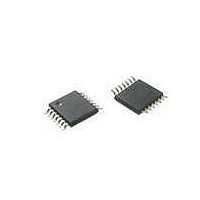ATTINY20-XU Atmel, ATTINY20-XU Datasheet - Page 155

ATTINY20-XU
Manufacturer Part Number
ATTINY20-XU
Description
MCU AVR 2KB FLASH 12MHZ 14TSSOP
Manufacturer
Atmel
Series
AVR® ATtinyr
Datasheet
1.ATTINY20-EK1.pdf
(224 pages)
Specifications of ATTINY20-XU
Core Processor
AVR
Core Size
8-Bit
Speed
12MHz
Connectivity
I²C, SPI
Peripherals
Brown-out Detect/Reset, POR, PWM, WDT
Number Of I /o
12
Program Memory Size
2KB (1K x 16)
Program Memory Type
FLASH
Ram Size
128 x 8
Voltage - Supply (vcc/vdd)
1.8 V ~ 5.5 V
Data Converters
A/D 8x10b
Oscillator Type
Internal
Operating Temperature
-40°C ~ 85°C
Package / Case
*
Processor Series
ATtiny
Core
AVR
Data Bus Width
8 bit
Data Ram Size
128 B
Interface Type
SPI, TWI
Maximum Clock Frequency
12 MHz
Number Of Programmable I/os
12
Number Of Timers
2
Operating Supply Voltage
3.3 V
Maximum Operating Temperature
+ 85 C
Mounting Style
SMD/SMT
Minimum Operating Temperature
- 40 C
Operating Temperature Range
- 40 C to + 85 C
Lead Free Status / RoHS Status
Lead free / RoHS Compliant
Eeprom Size
-
Lead Free Status / Rohs Status
Details
Available stocks
Company
Part Number
Manufacturer
Quantity
Price
Company:
Part Number:
ATTINY20-XU
Manufacturer:
Atmel
Quantity:
904
- Current page: 155 of 224
- Download datasheet (6Mb)
18.3.7
18.3.8
18.3.9
8235B–AVR–04/11
Serial Data Reception
Serial Data Transmission
Collision Detection Exception
Figure 18-5. Data changing and Data sampling.
The TPI physical layer supports two modes of operation: Transmit and Receive. By default, the
layer is in Receive mode, waiting for a start bit. The mode of operation is controlled by the
access layer.
When the TPI physical layer is in receive mode, data reception is started as soon as a start bit
has been detected. Each bit that follows the start bit will be sampled at the rising edge of the
TPICLK and shifted into the shift register until the second stop bit has been received. When the
complete frame is present in the shift register the received data will be available for the TPI
access layer.
There are three possible exceptions in the receive mode: frame error, parity error and break
detection. All these exceptions are signalized to the TPI access layer, which then enters the
error state and puts the TPI physical layer into receive mode, waiting for a BREAK character.
When the TPI physical layer is ready to send a new frame it initiates data transmission by load-
ing the shift register with the data to be transmitted. When the shift register has been loaded with
new data, the transmitter shifts one complete frame out on the TPIDATA line at the transfer rate
given by TPICLK.
If a collision is detected during transmission, the output driver is disabled. The TPI access layer
enters the error state and the TPI physical layer is put into receive mode, waiting for a BREAK
character.
The TPI physical layer uses one bi-directional data line for both data reception and transmission.
A possible drive contention may occur, if the external programmer and the TPI physical layer
drive the TPIDATA line simultaneously. In order to reduce the effect of the drive contention, a
collision detection mechanism is supported. The collision detection is based on the way the TPI
physical layer drives the TPIDATA line.
• Frame Error Exception. The frame error exception indicates the state of the stop bit. The
• Parity Error Exception. The parity of the data bits is calculated during the frame reception.
• Break Detection Exception. The Break detection exception is given when a complete frame of
frame error exception is set if the stop bit was read as zero.
After the frame is received completely, the result is compared with the parity bit of the frame.
If the comparison fails the parity error exception is signalized.
all zeros has been received.
TPICLK
TPIDATA
SAMPLE
SETUP
ATtiny20
155
Related parts for ATTINY20-XU
Image
Part Number
Description
Manufacturer
Datasheet
Request
R

Part Number:
Description:
IC, MCU, 8BIT, 2K FLASH, 20SOIC
Manufacturer:
Atmel
Datasheet:

Part Number:
Description:
IC, MCU, 8BIT, 2K FLASH, 20PDIP
Manufacturer:
Atmel
Datasheet:

Part Number:
Description:
IC, MCU, 8BIT, 8K FLASH, 20PDIP
Manufacturer:
Atmel
Datasheet:

Part Number:
Description:
IC, MCU, 8BIT, 8K FLASH, 20SOIC
Manufacturer:
Atmel
Datasheet:

Part Number:
Description:
DEV KIT FOR AVR/AVR32
Manufacturer:
Atmel
Datasheet:

Part Number:
Description:
INTERVAL AND WIPE/WASH WIPER CONTROL IC WITH DELAY
Manufacturer:
ATMEL Corporation
Datasheet:

Part Number:
Description:
Low-Voltage Voice-Switched IC for Hands-Free Operation
Manufacturer:
ATMEL Corporation
Datasheet:

Part Number:
Description:
MONOLITHIC INTEGRATED FEATUREPHONE CIRCUIT
Manufacturer:
ATMEL Corporation
Datasheet:

Part Number:
Description:
AM-FM Receiver IC U4255BM-M
Manufacturer:
ATMEL Corporation
Datasheet:

Part Number:
Description:
Monolithic Integrated Feature Phone Circuit
Manufacturer:
ATMEL Corporation
Datasheet:

Part Number:
Description:
Multistandard Video-IF and Quasi Parallel Sound Processing
Manufacturer:
ATMEL Corporation
Datasheet:

Part Number:
Description:
High-performance EE PLD
Manufacturer:
ATMEL Corporation
Datasheet:











